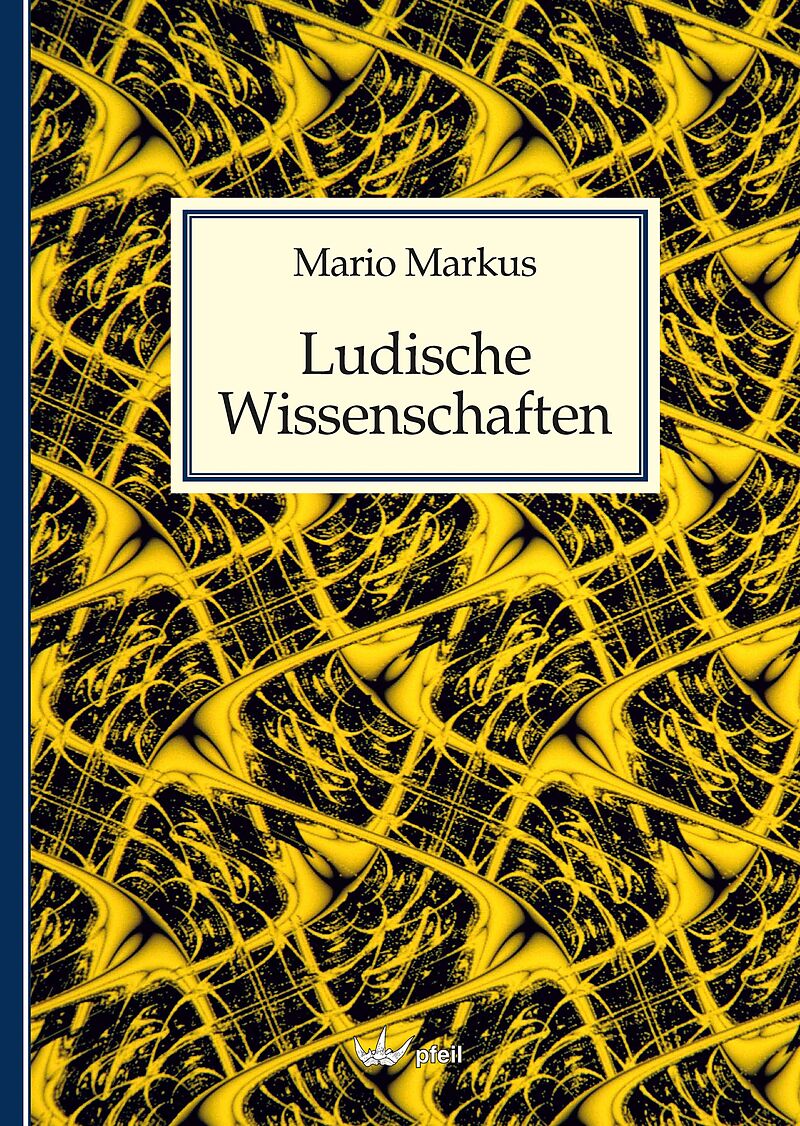Ludische Wissenschaften
Einband:
Fester Einband
EAN:
9783899372762
Untertitel:
Deutsch
Genre:
Naturwissenschaften allgemein
Autor:
Mario Markus
Herausgeber:
Pfeil
Auflage:
1. Auflage
Anzahl Seiten:
56
Erscheinungsdatum:
21.04.2022
ISBN:
978-3-89937-276-2
Synopsis of the book: Ludische Wissenschaften by Mario Markus, edited by Pfeil, Munich (2022) LUDIC SCIENCE Research projects are currently being promoted or awarded to an increasing extent under the aspect of concrete applicability. However, history teaches us that since antiquity we have stumbled across fundamental, new insights almost playfully out of our inner curiosity. In his book Homo ludens (1938), the Dutch art historian Johan Huizinga examines the role of play, or playing, as a creative source in many areas of science. Huizinga defines play as an act or activity that is accepted voluntarily and is accompanied by a feeling of tension and joy. According to Huizinga, play is the origin of all innovations, the place of origin of all major cultural formations. Huizinga states that this not to be understood in such a way that play changes into culture, but rather that culture in its original phases has something play-like peculiar to it, indeed that it is initially performed in the forms and mood of a game. Examples of games that are not technically transformed, that is to say exceptions, are for Huizinga dance, poetry and abstract art. Research with a purposeless attitude is called "ludic" (from Latin ludus, the playing) and is described below using various examples from the past. EXAMPLES The Leiden Bottle. A glass bottle with a piece of metal on the outside and one on the inside can store electrical charge. It was the first capacitor and was initially used only to produce a brotherly tingling when connected to a circle of hand-holding friends. Billions of such devices are now in miniaturized form in our smartphones. The Mendelian Rules. In the 1860s the benetictine monk Gregor Mendel observed the characteristics of pea plants in the course of their generations. To explain what he saw he conjectured that two factors determine the plant properties, each of which has one of the features that were later called dominant and recessive This formed the basis of genetic research. Hennig Brand distilled in the year 1675 his urine and obtained a substance that glowed in the dark. He thought he had discovered the essence of life. Actually, he had discovered a new chemical element: Phosphorus. Thomas Seebeck tinkered with soldering together different pieces of metals. 1821 he found that two wires, one of cooper and one of zinc, soldered together and with the wire ends held at different temperatures, produced an electric current. He thus discovered the first electric thermometer. László Biró saw 1928 his daughter rolling a marble through a puddle surrounded by dry earth. The water left a trace. From this point on he made an enormous number of experiments placing very small bearing balls at the end of a thin tube filled with ink. The ballpen he finally built in this manner was especially welcome in open airplanes, where the ink in traditional fountain pens flowed out because of the lower pressure outside. His ballpen factory made him a millionaire. A positively charged electron, called a positron, was a curiosity when Paul Dirac predicted it in 1928 by playing with mathematical formulae. Today, diagnosis with PET (positron emission tomography) is used at many large hospitals for the detection of tumors and other anomalies. The vacuum was a matter of discussion for philosophers since antiquity. It was questioned whether it exists. In 1675 Otto von Querike built an air pump to try to produce a vacuum. To do this he took two halves of a metal sphere (Diameter: 42 cm), stuck them together using a strong glue and extracted the air inside it using his machine. He then needed the strength of several horses to separate them, which was interpreted correctly as being due to the pressure of the air outside acting on the pressureless vacuum inside. Otto Hahn and Lise Meitner played the same game for years: Shoot neutrons on uranium to see if a chemical element heavier than uranium, the heaviest element at that time, was produced. In 1938 Hahn obtained an unexpected result: Instead of a heavier element, two lighter ones were generated: Barium and Krypton. He was disappointed, but Lise Meitner explained this: He had disintegrated the uranium atom. This was the first nuclear fission and the beginning of the atomic era, including bombs and nuclear reactors, all based on nuclear fission. Alfred Wegener, born in 1880, was intrigued by the similar form of the coast of the American continent and Africa. He spend all his life searching for a proof that both continents had once been connected. He did so by comparing living plants, fossils and rock structures. However, he was asked: How could the continents have separated? In 1960 it was discovered that volcanoes in the middle of the Atlantic Ocean make the continents drift. By this time, Wegener had already died. Samuel Fay played tirelessly with different foldings of wire to find out which folding could hold the greatest number of paper sheets with a minimum of wire length. He found in 1867 the paperclip that is still used all over the world today. This resulted in a patent, a substantial income and he is honoured in the Ealy Office Museum in New York. How did Chewing Gum become so popular? Thomas Adams, a tyre- producer from the US, visited Mexico and was disgusted when watching the indians chew latex juice, stopping only to sleep and to eat. He planned to carry a large amount to the US to try to incorporate it in his tyre-material. One day he decided to experiment by chewing for a while and liked it so much that he later became the largest chewing gum producer worldwide at that time. Sildenafil never became a drug that was not much liked by cardiologists because, although it does help in some cases, it has a lot of undesirable side effects. Nevertheless, after much experimentation in heart treatment, it produced one desirable side effect: erection in male patients. This side-effect had no side-effects and was called Viagra. The US-America engineer Percy Spencer worked for many years on magnetic amplifiers near to a radar setup. One day in the 1940s he noticed that a chocolate bar in his trousers had melted. Soon he found that the amount of melting decreased with the square of the distance from the radar, so it must be the effect of microwave radiation. He installed a radar machine, 1,80 Meters high, in his home and prepared his meals with it. Technicians who used his patent later built smaller and smaller ones until they reached the sizes we know now. Carl Friedrich Gauß played around the year 1800 with electric and magnetic circuits and showed that electric field lines converge, while magnetic ones diverge from a source. 1820 Hans Christian Oersted continued playing with circuits and found that an electric current produces magnetism. 1831 Faraday showed that temporally varying magnetism produces an electric current. 1865 Maxwell showed that not only an electric current but also a varying electric field produces magnetism. Maxwell put the results of all these games together into a set of equations with which he could show the existence of electromagnetic waves. Their variety is overwhelming: Gamma-rays, X-rays, visible light, microwaves, broadcast waves, just to name some of them. All 118 chemical elements, except iron, copper, silver, tin, platinum, mercury, lead, nickel and gold, which were all known since antiquity, have been the result of ludic experimentation: guessing, trying out, getting frustrated and finally finding. The steam engine began as a toy. About 100 a. Chr. Heron of Alexandria devised a boiler, the steam of it flowing into a sphere, which was free to rotate around its axis. Moreover, the sphere had two holes far from the incoming steam: one oriented to one side and the other to the opposite side. The streaming of steam from these holes made the sphere rotate. It was the first steam engine but it was not until 1769 that James Watt made a sufficiently efficient version to revolutionize industry and…

Leider konnten wir für diesen Artikel keine Preise ermitteln ...
billigbuch.ch sucht jetzt für Sie die besten Angebote ...
Die aktuellen Verkaufspreise von 5 Onlineshops werden in Realtime abgefragt.
Sie können das gewünschte Produkt anschliessend direkt beim Anbieter Ihrer Wahl bestellen.
Loading...
Die aktuellen Verkaufspreise von 5 Onlineshops werden in Realtime abgefragt.
Sie können das gewünschte Produkt anschliessend direkt beim Anbieter Ihrer Wahl bestellen.
| # | Onlineshop | Preis CHF | Versand CHF | Total CHF | ||
|---|---|---|---|---|---|---|
| 1 | Seller | 0.00 | 0.00 | 0.00 |
